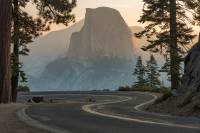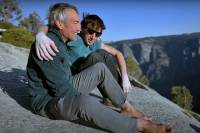Long-Term Yosemite Climbing Permit Structure Nears: What’s the Deal?
The comment period for Yosemite National Park’s finalized Wilderness Climbing Permit system ends Sunday. Here’s what you need to know.
In an age where climbers are Olympians and Oscar winners, it’s not a matter of conjecture that rock climbing is more popular than ever. And in arguably the most famous rock climbing destination on the planet, flocking crowds are becoming a crux. That can be especially true on big wall climbs, where trash, human waste, and abandoned gear stashes can become big problems.
So in 2021, Yosemite National Park officials intervened by requiring climbing permits for the first time in the sport’s 70-year history in the park. The National Park Service (NPS) sought to increase accountability among climbers in critical areas like Half Dome and El Capitan and develop a firmer grasp of traffic patterns.
But, the agency said this August its evaluation of that program showed results were not satisfactory. Now a new “long-term solution” is on its way.
View this post on Instagram
The good news is that the old days of tensions between Park Rangers and climbers have lapsed into something resembling collaboration. And through a relatively newfound and growing rapport, stakeholders at multiple locations along the spectrum are optimistic ahead of the program’s finalization.
However, rules on when and where you can climb had never existed before 2021, so details remain nebulous.
Today, 3 days remain until the comment period for the upcoming management plan ends. Here’s what you need to know about the complicated issue’s multiple sides.
What Is the Purpose of Yosemite Climbing Permits?
Right now, every climber planning to stay overnight on big wall climbs in Yosemite must first secure a wilderness climbing permit. In the current “pilot” program, permits are free and unlimited.
Now in place since Oct. 31, all climbers must obtain their permits at the self-registration kiosk in front of the Valley Visitor Center. During high season in the spring and fall, permit pickup locations have been more widespread.
Why do they exist at all?
For one thing, Yosemite’s big wall climbs exist almost entirely in federally designated Wilderness areas — the highest level of protection anywhere on public land. So, in the words of the NPS, “[b]oth park management and park visitors have a special responsibility to protect designated Wilderness for this and future generations.”
Because the program’s core purpose is protecting natural resources, Leave No Trace education plays a central role in its development.
A Collaborative Approach
Jesse McGahey is Yosemite National Park’s Head Climbing Ranger. His days in the park started when he arrived as a dirtbag climber in 2000, he told the RunOut podcast. During his explanation of his career in the park, it became clear that his transition to the Park Service occurred during a changing relationship between climbers and park officials.
“When I first started coming here, it was not the wild west, per se, but there was still this great animosity, I feel like, between climbers and rangers,” he told the RunOut.
But now, he said, camaraderie has built. Listing colleagues and climber-led groups like the Yosemite Climbing Association (YCA), he said, “that relationship has become more cooperative. We’re really starting to work together.”
Ken Yager, president of the YCA and Valley climber since the 1970s, weighed in on the progress.
“It’s nice to have people [in park roles] that are real climbers — and so they understand climbing. I think it’s a good thing because we’re an accepted part of society now versus a bunch of renegades that are hated,” Yager said. “You’re much more powerful if you can reach every user group for Yosemite.”
That newfound collaborative capacity could be vital in developing a plan that makes more sense for all parties involved.
Other advocacy groups like the Access Fund can also help ease any tensions.
Katie Goodwin is the nonprofit’s California Regional Director. She said her group’s primary role in the permit discussion is to ensure that park officials hear climbers’ perspectives. To do that, the Access Fund developed a series of talking points it encouraged commenters to engage with.
The list mainly includes specific suggestions for how to treat topics like quotas, fees, and structure. It also invites commenters to share their personal experiences. But second on the list? “Thank YNP for including climbers in the conversation around the permit system and encourage them to continue to accept stakeholder input.”
Goodwin said, “The direction we would like to work toward with the park, these are suggestions we’ve come up with that would allow for the least amount of heavy administrative regulation while also allowing the park to educate [users] and protect the resource.”
However, like everyone else embroiled in the discussions, Goodwin still can’t see a clear outcome.
The NPS has not released any official updates on policy since it announced the pending “long-term solution.” But two “Virtual Town Hall” meetings and a live discussion during the Yosemite Facelift have occurred over the last few months.
What Would a Plan That Bridged the Gap Look Like?
Shocker: there’s still a possibility we’ll go back to the old days of unlimited access, according to McGahey.
He told the RunOut that one option remains to kill the permit system altogether. But he also explained that anyone who wants to leave a comment in favor of it would have to offer alternative solutions to existing problems — trash on the wall, impact, etc.
However, some form of a permit system will likely exist. (Yager has watched the Valley climbing scene undergo as much change as anybody still there. In his words, “things are going to change. That can’t be helped.”)
By now, most, if not all, stakeholder groups are aligned on minimizing garbage and waste during climbs. It was Yager’s priority when he started the Facelift in 2004, and the Access Fund, Park Service, and thousands of volunteer climbers have jumped on board.
The most significant part of a permit plan that will address litter is education at the time of permit pickup — but how, and specifically how often, is up for debate.
How often will climbers need a Leave No Trace refresher course through the permit system? If you need a permit every time you do a wall, and it comes with the same schpiel, the process could grow to seem onerous.
But according to Goodwin, the NPS understands that. She said the agency is evaluating programs like Zion National Park’s Express Membership, part of its own Wilderness Climbing Permit system.
Through it, climbers who do multiple big walls in the park each year can trade a day of intensive education for the tedious process of getting a standalone permit for each visit. Applicants must watch three orientation films at the Zion Canyon Visitor Center. Their pass is then valid for 2 years and lets them snag permits in advance through their online account.
One thing that raised the hackles of every climbing interest group I talked to was whether recreation.gov would handle operations. The government contracts the privately owned company to manage access to resources across the U.S. While it typically delivers a decent user experience, its service fee structure raises eyebrows among those who question where the company chooses to spend the proceeds.
“The sentiment we’ve gotten from the community is that people really don’t like using recreation.gov. Every time you buy a reservation, $2 or more goes to this third party, and that tends to bug people,” Goodwin said. “It’s a conversation we’ve had with a lot of climbers, and with Jesse [McGahey]. Essentially, ‘how would these permits be administered?'”
Unfortunately, Goodwin said McGahey had become relatively convinced the park would have to use recreation.gov for any online permitting.
But onsite options could exist — kiosks at visitor centers and ranger stations are topics of discussion.
Goodwin and others could not comment on any possible fee structure — those decisions remain firmly in the hands of park officials.
Finally, a quota for permits issued is not on the table, McGahey told the RunOut. That’s because the park has not identified crowding on routes as significantly problematic.
Whatever answers park administrators land on, it seems clear that stakeholders will work together — not against each other — to help them get there.
McGahey called his Climbing Ranger program “robust” and said that its goal in discussions is “[t]o try to be a little more proactive instead of reactive” on the RunOut. (McGahey was not available for comment on this story.)
Yager pointed out that the choice between cooperation and its opposite is evident.
“These people are doing jobs where they’re being told to take care of [this resource],” Yager said of park officials. “We can either fight them and complain about things, or we can be involved and try to make it a workable plan that will work for everybody.”
He paused.
“And then keep climbing!” he laughed. “That’s what I’d rather see.”
To comment through the Access Fund (and source its prompts, if you want), go to the group’s Yosemite Wilderness Climbing Permit campaign page. To comment directly to the NPS, click here.
The post Long-Term Yosemite Climbing Permit Structure Nears: What’s the Deal? appeared first on GearJunkie.


